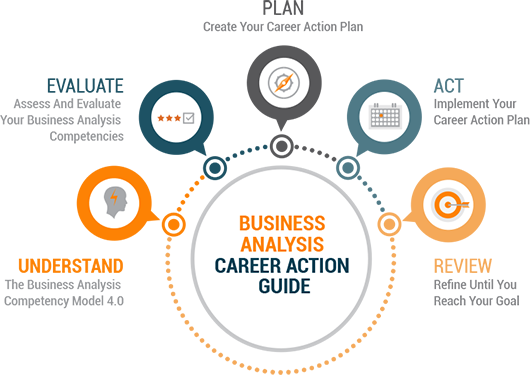4-Step Roadmap for Professional Success in the New Year
Receive free IIBA updates and exclusive content!
Like most of us you are eager to close the door on 2020 in hopes of soon bringing closure to a difficult and challenging year. While your career plans may have been derailed, you can still get back on track with these 4 steps to define your career path. Your 2021 career roadmap can help you lay out the steps to achieve your goal.

Step 1: Conduct a Self-Analysis
Where are you in your career path and where do you want to be? IIBA’s Self-Assessment Tool can help you audit your current skills and find areas for improvement. The tool asks a series of statements about corresponding experience and performance indicators to determine your competency level. You should take part in a self-assessment at least once a year. Usually, as busy professionals we tend to do this when it comes time to set our performance goals for the coming year. But it’s a good idea to do a personal skills inventory. Have you taken on new areas of responsibility? Are you interested in gaining experience in specific areas? If you are happy in your current role, consider looking for ways to develop your existing skills and improve your soft or transferable skills that will help you in any role. In the 2020 Global BA Salary Survey we asked respondents which soft skills were most important in their role. Check it out to see how your skills compare with the results.
Step 2: Professional Development Planning
Develop a training plan to increase your business analysis competency level by mapping your understanding of business analysis foundational skills, tasks, techniques, and personal characteristics to determine your proficiency level. IIBA’s Business Analysis Competency Model identifies 53 business analysis performance competencies with behavioural indicators and techniques associated with each level of business analysis performed.
Step 3: Take Action
Even if you love your current job and cannot think of ever leaving your current organization or playing a different role, it is still important to look ahead to ensure your skills are future proof. As we’ve all seen in 2020, change can happen quickly and sometimes unexpectedly. If you want to remain competitive it's important to have current, in-demand skills. Certification is a terrific way to demonstrate to your employer and your colleagues your experience level and business analysis knowledge. Complete IIBA’s Career Action Plan and sit down with your employer to discuss opportunities and what you can do to develop your skillsets and experience. Whether it is getting certified, submitting abstracts for conferences, or finding – or becoming – a mentor, your employer can help you build these career building opportunities into your annual work plan.
Follow IIBA’s five steps to unlock your potential by identifying areas of focus for professional development to grow your career.
Step 4: Create Your Future
Enlist your boss and or mentor to help you get their buy-in and support for your career development goals. Does your employer provide a training and development path to support your career? 22% of respondents in the 2020 Global BA Salary Survey said their employers always pay for training; another 22% said their employer usually pays while 27% indicated that their employer sometimes pays for training. If you work for a larger organization, you may benefit from a comprehensive training program similar to those at North Highland, RBC, and Nedbank.
64% of the survey respondents reported a lack of having a defined career development path. If your organization does not offer development opportunities advocate for yourself to try to gain the support of your boss and your company’s leaders to invest in staff’s professional development. If your boss is not advocating for you ask them what it would take to earn their support. Most employers recognize the value of coaching and mentoring to support growth and the return on their investment through improved productivity and increased engagement (not to mention more motivated staff). So, even if budgets are reduced you can still present a plan for them to support you. Perhaps a train the trainer model where you agree to share the knowledge you gain with your team. If you need help to get started check out IIBA’s Email draft to send to your decision maker and Business Case for Business Analysis which can help you put together a business case that includes facts and research to support key benefits in your request. One tip when writing your business case is to use language used by your employer to describe outcomes from training opportunities that will resonate with your employer’s goals.
If your employer expects you to manage your own development or does not have a training or membership budget, consider investing in yourself. Depending on your budget there are many options to explore. The most economical one is buying an annual professional membership that will give you access to resources, event access, certification discounts, networking, mentoring, and tools to support your upskilling.
Reflect, Revise and Repeat
Remember your career plan is a pathway to help you reach your goals. Developing your career plan requires time, reflecting on your competencies, your wants, and your goals. Setting a plan and mapping out how to get there is the first step you need to take. Along the way be sure to reflect on how far you’ve come, be prepared to shift your plan to address any unexpected obstacles (like COVID-19) and focus on your short term, midterm (2 to 5 years), and long term (>5 years) career roadmap.
